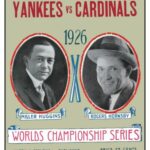History of the World Series – 1959
Times they were a-changing. Major league baseball underwent its first alignment switch in 50 years in 1953 with the transfer of the Boston Braves to Milwaukee, and then saw the St. Louis Browns move to Baltimore in 1954 and the Philadelphia Athletics shift to Kansas City in 1955. But it underwent a blockbuster makeover in 1958 when the New York Giants took up residence in San Francisco and the Brooklyn Dodgers settled into Los Angeles.
Los Angeles fans, expectations high for a club that had won four NL pennants in its last six seasons in Brooklyn, received a jolt in ’58 when the Dodgers made their West Coast debut by finishing two games from the basement. After a year of adjustment and the infusion of some new faces into a cast that had grown old in Brooklyn, the Dodgers rebounded dramatically in 1959 and captured the franchise’s seventh flag in 13 seasons.
The Dodgers, losers of two pennant playoffs in Brooklyn, won the ’59 NL championship by beating the Milwaukee Braves in two straight games in a best-of-three playoff after the clubs finished in a first-place tie with 86-68 records. With one old postseason jinx disposed of, the Dodgers took aim on another, the World Series. Unable to win the fall classic as a Brooklyn-based team until the club’s eighth go-round, the Dodgers went on to win the Series in their first appearance as a representative of Los Angeles. End of jinx No. 2.
The 1959 World Series between the Dodgers and the American League champion Chicago White Sox began at Comiskey Park, which hadn’t played host to a Series game since the concluding game of the scandal-ridden 1919 affair. The “Go-Go” Sox, featuring a Luis Aparicio-led running attack, excellent defense and top-line pitching, hauled out the lumber in Game 1.
Ted Kluszewski, a late-August acquisition from the National League and a man who three times hit 40 or more homers in an NL season, drove in five runs with a pair of two-run homers and a run-scoring single as Chicago pummeled Los Angeles, 11-0. Early Wynn (seven-plus innings) and Gerry Staley combined to blank the Dodgers, who suffered yet another tough day in the fall classic. In their last Series game three years earlier, the Dodgers had lost, 9-0, and they now had scored one run in their last four Series contests.
In Game 2, Chicago righthander Bob Shaw was guarding a 2-1 lead with two out in the seventh when Dodgers Manager Walter Alston sent up Chuck Essegian to bat for Johnny Podres, who had pitched creditably in his first World Series outing since clinching Brooklyn its only Series championship in ’55 (Podres had missed the ’56 season because of military service). Essegian boomed a game-tying home run to left. Jim Gilliam walked and Charlie Neal, who had smashed a bases-empty homer in the fifth, followed with a two-run homer to center.
Larry Sherry, a 24-year-old righthander who had been called up from St. Paul in early July, pitched the final three innings for the Dodgers, allowing one run and three hits. He slipped out of a jam in the eighth when Sherman Lollar was tagged out at the plate by John Roseboro when the White Sox’s catcher tried to score from first base on Al Smith’s double (which had driven in one run).
Buoyed by the 4-3 triumph, the Dodgers looked ahead to the first West Coast game in Series history.
When the Dodgers last played at home in a World Series — October 10, 1956 — cramped Ebbets Field in Brooklyn was the site. The attendance was 33,782. Jackie Robinson was at third base, Roy Campanella was the catcher, Duke Snider was in center field, Carl Furillo was in right, Gil Hodges was at first base, Pee Wee Reese was at shortstop and Don Newcombe was the pitcher.
Now, on October 4, 1959, Memorial Coliseum in Los Angeles was the site. The attendance was 92,394. Robinson was in retirement, having played his last big-league game in that ’56 Series finale; Campanella was in a wheelchair, having been paralyzed in a January 1958 automobile crash; Snider, a starter in the first two games of the ’59 Series, was supplanted in this game by young Don Demeter; Furillo was on the bench, having appeared in only 50 regular-season games in ’59; Hodges still held down first base; Reese had become a Dodgers coach, and the shortstop’s job was now in the hands of speedster Maury Wills, who had been called up from Spokane seven weeks into the season; and Newcombe now was a member of the Cincinnati Reds.
While Furillo was nearing the end of his career, he had one last big hit left. With Game 3 tied 0-0, Furillo delivered a two-run pinch single in the seventh and Los Angeles went on to a 3-1 triumph. Sherry got the final six outs for the Dodgers in relief of Don Drysdale.
Hedges’ eighth-inning home run decided Game 4 as the Dodgers prevailed, 5-4. Lollar had deadlocked the contest with a three-run homer in the seventh, but Sherry came on again in the eighth and kept Manager Al Lopez’s White Sox at bay.
Hoping to end the Series at home, the Dodgers sent 23-year-old lefthander Sandy Koufax to the mound against Shaw, who had enjoyed an 18-6 season for the White Sox. Koufax, still trying to get a grip on his control, was only 28-27 at this juncture of his major-league career.
Shaw, getting 1 2/3 innings of crucial help from reliever Dick Donovan, wound up a 1-0 winner in a game where the only run was scored on a double-play grounder (by Lollar, in the fourth). The Sox got a great defensive play from Jim Rivera in the seventh. Inserted into the game moments earlier, right fielder Rivera made an outstanding running catch of Neal’s two-out smash that carried near the fence in right-center, with Dodgers at second and third. For the third straight day, a big-league-record was set as 92,706 fans witnessed the action.
The Dodgers clipped Wynn and reliever Donovan for eight runs in the first four innings of Game 6 at Comiskey Park, with Snider starting the onslaught with a two-run homer in the third and Wally Moon adding a two-run shot in the fourth. The lefthanded-hitting Moon had been a major cog in the Dodgers’ pennant machine, perfecting an “inside-out” swing after his acquisition from the St. Louis Cardinals and becoming a master at driving balls off and over the Memorial Coliseum’s left-field screen (a mere 251 feet from the plate).
While starter Podres failed to be the pitcher of record this time around in the Dodgers’ Series-clinching victory — he lasted only 3 1/3 innings and yielded a three-run homer to Kluszewski — Sherry came through once more. Pitching 5 2/3 innings of four-hit, scoreless relief, he notched his second victory of the Series to go with his rescue efforts in Los Angeles’ other two victories. The Dodgers won, 9-3, with Essegian putting a topper on things in the ninth with an unprecedented second pinch homer of the Series.
The White Sox got 10 RBIs — a record for a six-game Series — and a .391 batting average from Kluszewski, and a .375 mark from Nellie Fox, whose bat work as the No. 2 hitter behind leadoff man Aparicio had been critical to the success of the “Go-Go” Sox. But with Sherry closing the door in one key situation after another and batterymate Roseboro making a big contribution despite a .095 batting mark (he helped limit Chicago to two stolen bases over the six games), the “Go-Go” team was gone-gone.




